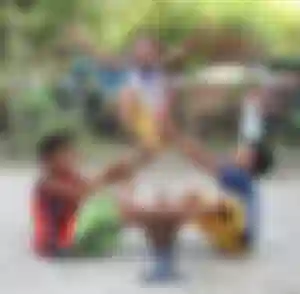February 03, 2022
Reminiscing the life we had before is the best pastime to do with our friends or family.
When we talked about the memories of our childhood or happenings in the past, the highlight of all the sharing is the games we played before that are being forgotten these days.
Life in the past is simple but fun, full of lessons, and the best part of it is how we explore and make things that turn into inventions of entertainment.
Do still remember the games you've been playing before during your childhood days?
Here in the Philippines, according to my parents during their childhood days technology is not yet bloomed and the people who can afford to have a television are those who are wealthy. So, to entertain themselves they have to improvise things and turn them into toys.
So, here’s our world before. Before the internet and social media were born. May this bring back your memories and tell the kids of today to get out of the room and get the sweat out there and try some of these games.
Luksong Tinik

This game can be played by a team or by pair, the first team/pair are the players, and the other team/pair served as the tinik (thorns).
So here’s how to play this. 2 kids should serve as tinik (thorns) by sitting while putting their foot above the other, at the same time raising their hands just like in the picture. It will gradually be raised if the team succeeds to jump higher than the sink. Another team’s turn if it fails.
Tumba Lata

This is an individual game in which you only need is a tin can and your slipper as a weapon.
This game is played by hitting the tin can (lata) using a slipper (pamato). A “Taya” guards the tin can. If the opponent did not hit the “lata” using his “Pamato”, the opponent should stay near his “Pamato” and wait for his teammates’ turn. If his teammates hit the tin can, everybody who hasn’t hit it should pick up their slippers and run like chased by the dog across the line since the guard (after picking up the “lata” and putting it to original position) will chase after them. If the other player gets caught, then he will become the new guard.
Shato or Shandong

Shato or Shatong is played mostly in provinces. This can be played by 2 players or by a team using 2 sticks “long” and “short” one. There should be a small hole on the ground enough to put the small stick above it. Using the “long stick”, the player should overthrow the “small stick” on the ground. The farther the small stick flies, the greater the score. The one who has the greater score will run and will say a prolonged "hatom or shatom".
Takyan or Sipa

Most Filipinos would not get past childhood without playing Takyan or Sipa. This homegrown game is popular among children in both neighborhood and school playgrounds in the Philippines because of its simple rules and accessibility. But it is also exciting and challenging as it requires agility and speed as well as good control skills.
Takyan or Sipa in tagalog, is one of the traditional games here in the Philippines. The player must continuously hit the takyan with his/her foot or elbow without dropping it on the ground. The player who did the most number of kicks without dropping the takyan will the winner.
Patintero

The best game ever. Most kids are on the silent streets playing this game. The rule is simple, don’t let the “bantay’s” or opponent team tag you or your team will be the next “bantay”. The “bantays” can only step in the line so stay out of it, if one of you successfully crosses the final horizontal line, your team gets 1 point.
Luthang

Luthang (Filipino Kids Game) – Luthang is a Filipino kids game which means bamboo gun. Kids in the Philippines especially in the rural areas are playing this kind of game.
A luthang's bullet is a piece of wet paper. Or, whenever available, any small seed, like that of a mung bean (mongo in Pilipino) makes a powerful impact on the “enemy”. The “war” game is also called luthang. It's a boys' game. Although at times, girls do participate in it.
Chinese Garter

Chinese Garter, a game requiring flexibility, adjust and coordination, is a famous game for Filipino kids, most particularly among young ladies amid their elementary years. The game rotates around a normal garter, around a few yards in length, which be brought from the sewing store at around twenty pesos or less.
This is the way the game played. Initially, there ought to be two individuals holding the two ends of the garter which is extended on a level plane while others are attempting to transfer over to the opposite side of the garter. The primary objective of this game is to crosswise over the garter without being tripped. In each round, the stature of the garter increases. The garter by and large begins from the lower leg – level and after that knee – level, et cetera until the point that the garter is situated overhead. Higher rounds request agility since players jump with their feet first noticeable all around and they traverse the strap and wind up arriving as an afterthought. This implies players ought to be dexterous, rationally gifted and should have beauty keeping in mind the end goal to complete the game. Also, doing cartwheels (to cross the strap) in higher levels is allowed.
Luksong Baka

Luksong baka is a traditional Filipino game that originated in Bulacan. It involves a minimum of three players and a maximum of 10 players, and involves them jumping over the person called the baka, or "cow". The main goal of the players is to successfully jump over the baka without touching or falling over the baka.
Palo-Sebo

PALO SEBO is one of traditional game in the Philippines, where CONTESTANTS try to climb the pole in turns to secure the prize, and anyone who fails to reach the top is disqualified.
Long and straight bamboo poles are polished and greased, after which a small bag containing the prize is tied to the top. The bag usually contains money, sweets, or toys. Sometimes a small flag is used instead of the actual prize, which is given to the winner afterwards.
Tagutaguan

Batang 90’s will never forget this one where you have to hide everywhere trying not to be seen by “taya” or “it”. In our barrio, this is how we do it. A taya should sing some song or count from 1 to 10 in a “base” (wall or post) after that, everybody should have gone to somewhere to hide.
While the “taya” is looking, the players should do the stealth mode to get to the base and tap it in order to be saved. The first one got caught without touching the base becomes the new “taya”.
Source : https://touristspotsfinder.com/10-pinoy-games-batang-90s-will-never-ever-forget/
Holen

Marbles, locally known as Holen or jolen, is one of the traditional games played by Filipino children. There are various types of games using marbles. Two of the most common variants of these games are: first, the type in which the players try to knock their opponents’ marbles out of a circle with their own marble (and so win them); and second, the type in which the players try to hit a target and roll their marble through a hoop or into a hole by rolling, throwing or knuckling the marble.
Knuckling down. Among the many techniques mastered by those who play holen is “shooting”, done by holding the marble between the bent index finger and the knuckle of the thumb then flipping the marble forward towards its target by the straightening action of the thumb. This must be done “knuckles down” which means that the knuckle of the hand doing the shooting must be pressed to the ground when the marble is released.
Piko

Piko is the Philippine variation of the game hopscotch. The players stand behind the edge of a box, and each throws their cue ball. The first to play is determined depending on the players' agreement (e.g. nearest to the markings of the moon, wings or chest).
Dampa

Dampa. This is a game of rubber bands, called lastiko. Dampa involves moving the rubber bands with the air produced by hitting the ground with their hands. To produce the compressed air, the hands should be put together, palms down and arched like a dome before hitting the ground.
Luksong Lubid

Luksong lubid is the tagalong term for jumping rope. The game is traditionally played with two individuals swinging a rope in a circle while players take turns jumping while singing or chanting. If a player is out to the rhythm of the steps hereby hitting the rope, the next player will take turns while the loser will be the one to swing the rope. Through the evolution, there were techniques created in the procedure. Some of the techniques included are jump forward, jump backward, alternating foot, double under, and many others. Jumping rope can also be done alone while performing tricks.
Teks

Teks is a card game played by children in the Philippines. The objective of the game is that the player makes a bet on which side of the card will show after flicking or tossing the cards in the air. ... The winner then collects the other players' cards. Teks were sold in "sari-sari" stores or by vendors near schools.
Turumpo or Trumpo

Turumpo or trumpo is a native Filipino game that is popular as an outdoor game in the ’80s. Turumpo’s shape is a combination of half-sphere on top and conical section at the bottom where the common iron nail is attached. The body size usually varies from 4 to 6 cm in height with the nail 2 to 4cm in length. The wooden material is usually hardwood such as “bayabas“, “ipil”, or “sampaloc” so that it will be durable from the hits of other players during the group game. Playing turumpo is manipulated using “tyate“, an 80 to 100 cm string to be twirled starting from nail tip to the half of wooden body then throwing it in the flat ground. “Tyate” has a single knot at one end and a knot with “tansan“(cover of glass soft drinks) on the other end.
Playing “turumpo” has many variations, it can be played by a group or by single only in a form of exhibitions. Exhibitions are done by spinning it on the flat concrete surface and observe how is the duration and quality of its spinning. We called it “kangkarot” if the spinning is not balanced that makes it easy to stop and makes irregular movement, which usually happens if the nail was not attached in the center of the nail is not sharpened. We called it “matining” if the spinning of “turumpo” is smooth and will take a longer time to stop. Another exhibition is by throwing “turumpo” in the air and catching it with your palm or with the “tansan” at the end of “tyate”.
Palo Gulong

This is a fun game where you will race using a used tire of a motorcycle and a paddle or a stick.
Sungka

Sungka is one of the most popular Filipino games. ... Sungka is a game of skill in calculation played commonly by women and children. It is played on a block of wood or game-board called sungkahan. The gameboard is shaped like a boat with the surface artfully rounded or slightly pointed at the ends.
And many more recreational games. Simple and happy life, but sad to say these games are been forgotten nowadays because of gadgets that's why children nowadays are lack of physical exercises and prone to obesity due to overusing of technology.
Did you experience playing one of those games? Comment down below!
Thank you for giving time and effort to read my article. It means a lot to me.
Quote of the Day:






















halaaaaaa, 10-20, luksong baka, pogs, langit lupa tska agawang base.
naalala ko nung highschool ako, sports samin ang patintero. hahahha may scoring pa yern. namiss ko na maging bata ulit haaaay.